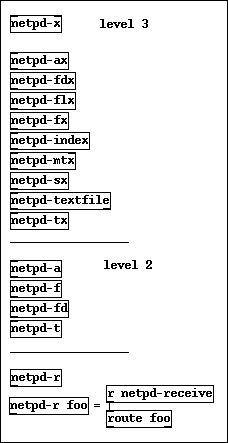netpd-abstractions

about netpd-abstractions
as a netpd user only, you never get in touch with netpd-abstractions, since they are used by netpd-patches and hidden in the inwards of them. if you are not interested in developing [netpd-patches]? yourself, you can stop reading here.
their goal is to make the synchronization of specific data sets across several instances of the same netpd-patch on different clients easy and feasible. let's say you have a slider, that controls the frequency of your patch and you want your patch to work the netpd way, you just need to add a [netpd-fx] with proper arguments to your patch and the slider is synchorized on each client, which means that your patch is a netpd-patch now.
description
for more details and better explanations check the help-patches.
- [netpd-x]
- is not used to for sychronizing a specific data set, but keeps a whole netpd-patch in sync with others. it is kind of the master of all level3 abstractions (the ones ending with ..x). only one instance is needed per patch. through [netpd-x] presets for the whole netpd-patch can be saved and restored.
synopsis : [netpd-x $0 <patchname>] - [netpd-ax]
- is used to synchronize an
anythingmessage (with or without list selector)
synopsis : [netpd-ax $0 <sendsymbol>] - [netpd-fdx]
- works the same as [netpd-fx], but broadcasts its value only after a short delay in order to save network bandwidth.
synopsis : [netpd-fdx $0 <sendsymbol> <receivesymbol> <initvalue>] - [netpd-flx]
- works the similar to [netpd-fx] ... MORITZ - where is the helppatch? i don't know, what this one is for.....
synopsis : [netpd-flx $0 <sendsymbol> <receivesymbol> <initvalue>] - [netpd-fx]
- synchronizes a single float value. can be used to netpd-ify slider, numberboxes, toggles (etc.?).
synopsis : [netpd-flx $0 <sendsymbol> <receivesymbol> <initvalue>] - [netpd-index]
- is a netpd-ified version of zexy's [index] object. it synchronizes an index-list (see help of [index]).
synopsis : [netpd-index $0 <sendsymbol> <maxnum_of_elements> <auto{0/1}>] - [netpd-mtx]
- is a netpd-ified version of iemmatrix's [matrix] object. it synchronizes a matrix (see help of [mtx]).
note: requires the iemmatrix -library.
synopsis : [netpd-mtx $0 <sendsymbol> <rows> <cols>] - [netpd-sx]
- is used to synchronize pd's symbolbox.
synopsis : [netpd-sx $0 <sendsymbol> <receivesymbol> <initvalue>] - [netpd-textfile]
- is a netpd-ified version of pd's [textfile] object. all methods, that affect the current data in [netpd-textfile], are broadcasted. methods, that poll the existing data, are executed only locally as well as the file IO methods.
synopsis : [netpd-textfile $0 <sendsymbol>] - [netpd-tx]
- does synchronize an array/table.
note: a change to the table will not be synchronized immediately, but with a certain rate. the bigger the table, the lower the update rate.
synopsis : [netpd-tx $0 <sendsymbol> lt;tablesize>]
abs without dump-on-load and without preset mechanism:
- [netpd-a]
- same as [netpd-ax], but without extended features.
- [netpd-f]
- same as [netpd-fx], but without extended features.
- [netpd-fd]
- same as [netpd-fdx], but without extended features.
- [netpd-t]
- same as [netpd-tx], but without extended features.
sometimes usefull:
- [netpd-r]
- universal receiver for any data.
synopsis : [netpd-r <sendsymbol>]
